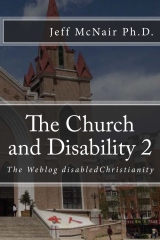As a reader of this blog, you will recognize the name Wolfensberger. Dr. Wolfensberger has had a significant impact on the way I see services for persons with various disabilities. He will be coming to Cal Baptist, Feb 27 & 28 to do a training on The history of human services. It will be excellent! See a description of the event below.
McNair
A two-part two-day presentation on the history of human services, tracing the origins of some of our major contemporary service patterns, & some universal lessons which can be learned from this history.
Presented by Dr. Wolf Wolfensberger, and Ms. Susan Thomas of Syracuse University’s Training Institute for Human Service Planning, Leadership and Change Agentry
Dates & Times:
9am-430pm each day
Saturday, February 27 and Sunday, February 28, 2010
Place:
Yeager Center, California Baptist University
Fee:
75$ per person for Day 1 only
125$ per person for both days.
In order to attend Day 2, participants MUST first have attended Day 1.Reductions in the fee are available; contact the registrar.
Description of the presentations:
For each day, the entire morning, and part of the afternoon, are devoted to presentation of content. This is followed by open-ended questions-and-discussion for the remainder of the afternoon.
Using several hundred slides from many (often obscure) sources, this two-part presentation documents the evolution of major human service concepts and practices from ancient, informal, voluntary, unpaid personal helping forms to the largely commercialized patterns that we see today. Especially, illustrations of the architecture of human service settings will be used to show what the service patterns and assumptions were in a given era, and how they changed over time.
The first part of the presentation (Day 1) will sketch important prehistoric and pre-Christian antecedents of current human service patterns, and will show that the history of human services of all types in inextricably intertwined with the history of care for the poor, and of residential services. The evolution of human services into the late Medieval period will be traced, and the impact of the collapse of medieval services preceding and during the Reformation will be explained. The presentation will also explain the negative effects of political and economic changes during the period of absolutism in the 16th-17th centuries.
The second part of the presentation (Day 2) will explain how services became alienated from their valued cultural roots and analogues, and how service recipients of all kinds began to be interpreted as menaces and treated accordingly in brutalizing fashion. At the end of Day 2, universally applicable lessons from this historical review will be drawn, as well as some lessons that are more particular to contemporary services.
The entire presentation will demonstrate how the following current human service ideas evolved: that bigger services are better services; that afflicted people are a menace to society; that segregated services are preferable to integrated ones; and that service recipients should be thankful for what they receive from service workers. The presentation will demonstrate that human service concepts were propagated rather uniformly throughout the westernized world, and leapt across barriers of language, nations, and culture, as early as medieval times. Even then, there was an international human service community which was very well informed of innovations anywhere, so that innovation was often copied elsewhere as quickly as it is today. It will also show how human services are more effective when they are deeply rooted in the historical traditions and values of their culture, and that the drift of services away from cultural-rootedness and toward non-normative and culture-alien approaches contributes so much of the disfunctionality that infects current human service structures and practices.
The presentation as a whole will compellingly demonstrate that human services are full of practices which are now carried on unconsciously, but which are actually vestiges of distortions of practices that were originally instituted with high consciousness.
Even in advanced graduate training, there is very little teaching of this history of human services. This material is relevant to every human service worker, form those on the direct clinical level to those at the highest planning levels, including service professionals and non-professionals, clinicians, advocates, volunteers, administrators, planners, theorists, and analysts. Attendance at the presentation can help anyone gain a better understanding of the service challenges that confront them, some of the dangers that lurk everywhere, and what sorts of service patterns to strive for. Many people who have attended this presentation have remarked that it fundamentally altered their perception of many human service patterns and that it helped them to understand -often for the first time- some of the things they had witnessed, or of which they were a part, or to which they had contributed. Persons who have been through PASS or PASSING training will also find that the presentation can help them greatly to master the very challenging issue of “model coherency” of human services.
Each day there will be a break for lunch and short breaks in mid-morning and mid-afternoon. Because of the highly sequential nature of the material, no one may be admitted to Day 2 of the presentation who has not been to Day 1.
Who should attend:
The presentation is relevant to anyone who is involved in any way in any kind of human service to any societally devalued group in any service field. For instance, for people involved/interested in residential and institutional services, the presentation shows how various specialized institutions grew out of the multi-purpose institution and workhouses for all kinds of afflicted and poor people of the 1600-1700s, which in turn grew out of the small, early Christian hospices.
Of special interest to people who are involved/interested in nursing homes, medicine, and psychiatric services, the presentation will trace several practices and typical architectural styles found in current medical settings from their origins in the practices and structures of early Christian residential services for the sick, pilgrims, and the poor. For example, it will be shown how the nurses’ station evolved from the early Christian service practice of placing an alter in the service setting so that all people there could see and hear the Mass being said. Also, considerable coverage is given to the impact of infections disease, the role of leprosy and the plagues on the design of other kinds of services, and the role of “miasmic theory” of disease propagation. Similarly, the ties of hospitals and other medical settings to concentration and death camps will be documented. For example, the evolution of the tuberculosis sanitarium from the pesthouses of the 1500-1600s will be documented, as well as how different kinds of quarantine-related institutions contributed to the development of concentration camps. It will also be shown how some famous institution architectural designs that are still copied today grew out of the miasmic theory that human afflictions were passed on by winds and “vapors.” The negative features of the separation of medicine from its ties to philosophy and religion, and its conversion into an essentially materialistic science, will also be noted, particularly in regard to the field of psychiatry. Slides will be shown that illustrate the mechanical (and rather brutal) psychiatric treatment devices which sprang up mostly during the 1800s, largely in response to psychiatry’s rejection of the “moral treatment” reform of mental health services.
Of special interest to people involved/interested in prisons and corrections services, the presentation will show how many of the concepts in the prison system and prison architecture of today are actually corruptions and perversions of very noble ideals. For example, it will be shown how prisons lost their culturally normative appearance; that the guard station and gun emplacements in so many prisons are descendents of an earlier custom, in which the altar was the focal point of the setting; and how, over time, prisons came to be located away from population centers and to acquire all sorts of menace imagery.
To register
Contact Dr. Jeff McNair (California Baptist University, 8432 Magnolia Ave., Riverside, CA 92504, phone 951/689-5771, fax 951/343-4553, email:jmcnair@calbaptist.edu. Upon registration, registrants will receive information, including on accommodations.
This event is sponsored by,
The Inland Empire Health Plan (IEHP)
The Disability Studies Institute at California Baptist University
California Baptist University Faculty
Inland Empire Autism Society of America (IEASA)
Wednesday, December 16, 2009
Subscribe to:
Post Comments (Atom)











2 comments:
Great opportunity.
oh nice! I want to come to this event
Post a Comment